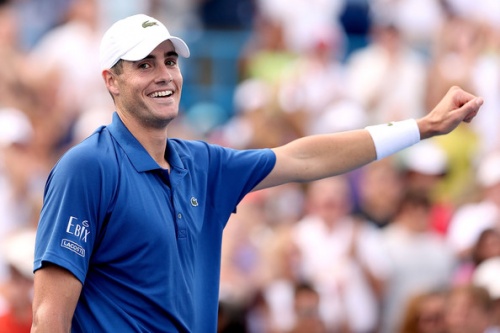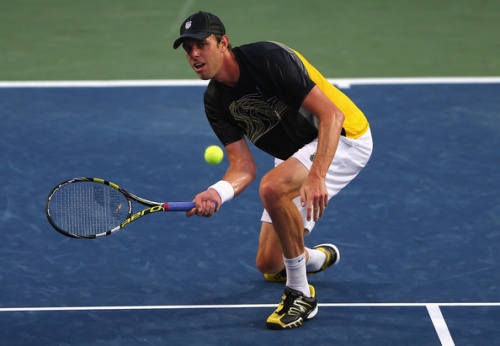Don't miss any stories → Follow Tennis View
FollowAmerican Towers Stand Tall: John Isner, Sam Querrey Secure Openers
Since Andy Roddick retired at last year’s US Open, the pickings have been few and far between for his countrymen. Just two American men remain in the top 70 of the ATP rankings, and none has reached a semifinal at a major.
The burden of expectations has weighed heavily at times on Roddick’s successor as the top-ranked American man, John Isner. Struggling throughout the first half of 2013, Isner finally burst free from his slump at the US Open Series. The giant Georgia Bulldog not only won Atlanta and reached the final in Washington but enjoyed perhaps the best week of his career in Cincinnati. Isner defeated four consecutive top-15 opponents, including world No. 1 Novak Djokovic, to reach his second Masters 1000 final as he proved how much fast courts and home soil can elevate his game.

A former US Open quarterfinalist, Isner arrived in New York looking to atone for a disappointing exit in the first week last year. He signaled how seriously he views this fortnight by withdrawing from his home tournament in Winston-Salem the previous week. While he will remain forever famous for winning the longest match in tennis history, Isner has fallen prey to accumulated fatigue at majors before. Shaped around the strengths and weaknesses imposed by his size, his game combines a nearly impenetrable serve with a fallible return.
That combination produces tiebreak after tiebreak and matches that hinge on just a handful of points. Isner’s reliance on a single shot, the serve, means that anyone can threaten him on any given day just as he can threaten anyone else. To build a deep run, then, the top-ranked American needed to dispatch early opponents like Italian clay specialist Filippo Volandri with minimal drama and maximal efficiency.
Isner mastered that task on Tuesday, conserving energy for the rounds to come. Volandri’s best career achievement by far had come on clay at his home tournament in Rome, where he stunned Roger Federer en route to a 2007 semifinal. Like Schiavone against Serena on Monday night, he faced a stark power disadvantage against Isner and could not rely on his serve to provide free points. The American reeled off an easy break of serve in his first return game and lost no time in imposing his own serve.
That situation would dishearten many a competitor more skilled than Volandri, and the Italian’s shoulders sagged quickly. In what seemed a matter of minutes, the first set rushed away in the first bagel that Isner ever had served on a hard court. Volandri never held a game point or break point in that set, so his fortunes could only improve from there.
And soon they did, as Isner labored through a long deuce game on his serve to start the second set. So easily had he claimed the first that the home hope perhaps grew a shade too complacent. Once he escaped that danger, though, Isner continued to move and react on return games with the alertness that he had shown in Cincinnati. Volandri could not count on the routine errors that his opponent has donated often in his career, but he withstood the pressure to finally put himself on the scoreboard.
The underdog was not so lucky at 1-2 in the second set, however, dropping serve at love to relieve Isner of whatever concern might have flitted across his mind. With that brief patch of scratchiness behind him, the American settled into cruise control. He clinched the second set with a break in the eighth game, denying Volandri any hope.
After each man held serve five games into the third set, Isner pounced efficiently in the sixth game to claim the only break that he needed. After his 6-0 6-2 6-3 victory, in which he faced just two break points, he advanced to face Gael Monfils in the second round. This intriguing matchup of American power and Gallic flair should receive marquee treatment on Thursday.
***
Isner’s comfortable passage into the second round contrasted with the effortful progress made by second-ranked American man Sam Querrey. Also dormant for much of 2013, Querrey had reclaimed some confidence by reaching a Winston-Salem semifinal last week. But little-known Guido Pella would test that confidence more than many of us expected.

After he could not convert a set point in the twelfth game of the first set, Pella allowed Querrey to pull away in the tiebreak behind his superior weight of shot. The Argentine rallied early in the second set, not allowing that disappointment to unglue him, while Querrey failed to make significant inroads in return games despite his opponent’s modest serve. Although he dug a 0-30 hole when serving for the set, Pella rallied to win three straight points and hold his second set point in as many sets. He wasted it with a nervous drop shot into the net and fluffed another with a careless forehand. Still, Querrey spurned two break points with makeable errors on backhand passes before surrendering the set to level the match.
Had he not saved a set point in the first set, then, Querrey would have trailed this anonymous opponent by two sets to love. His fans must have felt relieved and worried in equal measure, for Pella does not approach the quality of future opponents whom their man will face. With Roger Federer looming a few rounds ahead, Querrey could not afford to make mountains out of molehills before then. He toiled to earn a quick break in the third set, halting Pella’s momentum in its tracks.
The Argentine received treatment on his left wrist at the next changeover and faded from there, winning only three games over the third and fourth sets. While Querrey finished the match more promisingly than he started it, he still needs to play the key points with greater authority than he did against Pella. The American No. 2 must show more impressive tennis against Adrian Mannarino in the second round for fans to believe that he can threaten Federer next Saturday.










